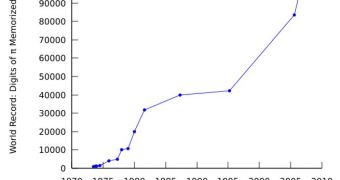Using nothing more than a home desktop computer, scientist Fabrice Bellard managed to calculate an additional 127 billion digits that followed the number 3 in Pi. The concept is a mathematical constant whose value is the ratio of any circle's circumference to its diameter in certain kinds of geometry. Usually, the number is used in its “restrained” form of 3.14159, but mathematicians and other scientists want to know precisely how long it is, and what the patterns inside are. The new calculations, which bring the total number of known digits in Pi to about 2.7 trillion, took 131 days to compute.
The previous record as far as these digits went was established just six months ago by University of Tsukuba expert Daisuke Takahashi. The Japanese researcher used a supercomputer for his calculations, and only needed about 29 hours to produce 2.6 trillion digits. But Bellard says that he did not have access to a supercomputer and that, although it may seem counterintuitive given the number of hours it took him, his method is actually more efficient than others.The supercomputer Takahashi used was about 2,000 times faster, and several thousand times more expensive than the desktop one Bellard had.
The new Pi number occupies about one terabyte of computer hard drive space, experts say. If each of its digits took one second to pronounce, more than 49,000 years would pass until all of them would be mentioned. In order to boost knowledge on this number, Bellard used a mathematical method known as arbitrary-precision arithmetic. “I got my first book about Pi when I was 14 and since then, I have followed the progress of the various computation records. I am [however] not especially interested in the digits of Pi,” the scientist told the BBC News.
“Arbitrary-precision arithmetic with huge numbers has little practical use, but some of the involved algorithms are interesting to do other things.” he added. Knowing additional billions of digits from this number is something that he would pursue only depending on his motivation, as Bellard put it. However, he does plan to use the algorithms that were part of the equations to work in other applications.
“Newton himself worked on the digits of Pi and spent a lot of time using one of the formulas he developed to get a few extra digits. People have used it as a vehicle for testing algorithms and for testing computers; Pi has a precise sequence of digits, it's exactly that, and if your computer isn't operating flawlessly some of those digits will be wrong. It's more than just for the fun of it – Pi is a way of testing a method and then the method can be used for other purposes,” the Director of publications at the Mathematical Association of America, Ivars Peterson, said.

 14 DAY TRIAL //
14 DAY TRIAL //